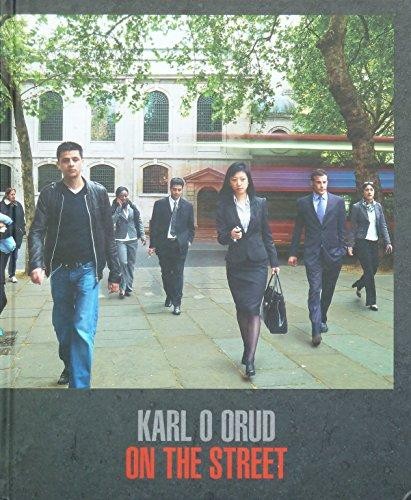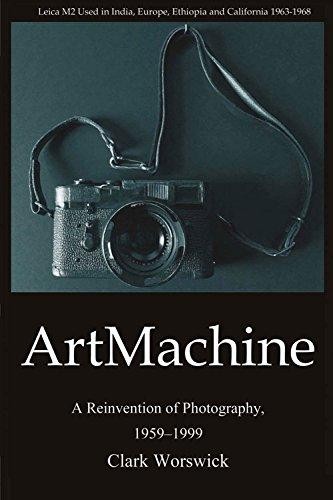Part 1: Paris Photo Week Observations and Dealing with Change
Important Gérard Lévy Photo Collection Goes up for Sale in Paris on Dec. 20th at Drouot
Photo Books: Photography on the Street, and around the World

KARL O ORUD: ON THE STREET.
Published by nedenfor hoyden, Norway. Hardbound; 105 pgs.; 73 full-color plates. ISBN No 978-82-92572-12-2. Information: karlorud@online.no .
Norwegian photographer Karl O Orud is at once straightforward and subtly deceptive in his street photography, shot in a broad mix of places in Asia, Europe and the U.S.
On one hand, he may deliver vivid, color-saturated portraiture of simple facades and simply arrayed subjects--especially in his sensitive, frontal images of the distinctive homes and black families on the porches of New Orleans neighborhoods in 2010.
But in other streetscapes, such as on the Pont Alexandre in Paris, New York's busy 5th Avenue, or the teeming markets of Benares, India, Orud will offer a surreal manipulation, combining multiple images of people on a common street background shot from the same camera position over a period of hours. The effect is just slightly hallucinatory, as when an embracing couple focus the Paris night for us in the glare of gilded monuments; and we notice, on closer inspection, that same couple arriving at the spot of their embrace only a few seconds before.
Orud's technique is even more effective in his crowd scenes, where multiple brides, grooms, bridesmaids and children may fill the frame in a church courtyard in Kiev, or when a darkly dressed contingent of multiples are gathered outside a country church in wintry Sarpsborg, Norway. Orud's moments are less than decisive, obviously, when he mixes time like this, and the effect is to coax a longer, deeper look from us.
His experiments are also less effective when he plays with motion, as in a 2006 shot of a pregnant woman relaxing on a towel in a green meadow, while a sequenced blur of another woman strolls past in the background. These effects only draw attention to themselves, while the doubled image of a monk making his way on a 2016 morning in Myanmar--walking toward us in the center of the frame, and also behind himself some 20 feet away--suggests the mystical present in the everyday; and it's truly wonderful--as are the busy throngs of people and boats combined for us on Venice piers or a Yangon/Myanmar harbor.
Stephen Bagnold provides some succinct context for Orud's work in his introduction, noting that the photos "have the capacity to create a world of dream-like 'new time,' dislocated from our normal sense of a single moment." Whether tricked up or not, Orud's images are sweepingly composed and express his rich aesthetic curiosity.

TWENTY YEARS. PHOTOS BY JASON LANGER.
Radius Books, Sante Fe, NM. Hardbound; 185 pgs.; approximately 90 black-and-white plates. ISBN No. 978-1-934435-78-6. Information: http://www.radiusbooks.org ; http://www.artbook.com.
In utter contrast to Orud's brightly hued, intensely managed street photography, Jason Langer's work over the course of two-plus decades reminds us of the found, night-drenched mysteries of Atget, Brassai, and others, with masterly control of exposure, framing and formal effect. Langer is drawn to the unforced surrealism of shop windows full of hats floating on their wire stands, as well as to the timeless noir of nighthawks at an anonymous diner in 2002, the car-lit canyons of New York, or the shadowed creepiness of faceless figures glimpsed in dim doorways or behind screens.
Langer, a native of Oregon known for his printing as well as his own work, and whose artistic quest has led him, notably, to the rare medical specimens stored in Paris's Faculte de Medecine, has a taste for the macabre, but never at the expense of photographic truth. A girl shot from ground level lying on the grass of a cemetery in 1990 suggests a fresh corpse, perhaps, but she also breathes life and renewal into the dusky scene. And a man glimpsed from behind, walking along a wet, lamp-lit street, is an urban vision of solitude and unknowability.
If anything, Langer opts for the opacity of night, as well as of his subjects; rarely do we see their faces. People walk away from us in the impersonal shoulders of great buildings, or we see their backs in prayer amid votive candles, or their shaded profiles as they talk on pay phones in the glare of neon beer signs. Even the most intimate images, of a couple embracing, or of a woman seated before a mirror, or of erotically charged nudes or models posing close to the camera, tend to be turned away or hidden.
Yet Langer's emphasis is always in service to the formal glories of a perfectly composed shot, and if the romanticism of a man seen staring--again, from behind--into the Seine under gloomy night skies is theatrical, it doesn't yield to cheap sentiment. These are palpably people, and their emotions emanate through Langer's lens. "Ultimately, Langer's solitary man goes in search of clues of the metaphysical variety," writes John Hill in his essay, "asking all the while: Who are we? Why are we here? What's the unseen reality?" Familiar questions, yes, but Jason Langer's work gives them a fresh, affecting airing.

RIJKSMUSEUM STUDIES IN PHOTOGRAPHY:
VOL. 14: AROUND THE WORLD IN 87 PHOTOGRAPHS: DOLPH KESSELER'S GRAND TOUR, 1908.
VOL. 15: ARNOLD GENTHE. PIONEER OF DANCE PHOTOGRAPHY.
Hardbound; each volume approximately 50 pgs; numerous illustrations. ISBN Nos. 978-94-91714-63-4 (Vol. 14), 978-94-91714-77-1 (Vol. 15). Information: http://www.rijksmuseum.nl .
These latest volumes from the Netherlands' Rijksmuseum pay homage to the seriousness with which the museum treats its photographic holdings, which it has only been assembling since 1996.
Thanks to editors such as Mattie Boom and Hans Rooseboom, and to the Manfred and Hanna Heiting Fund, the museum's Studies in Photography series has delivered a regular sequence of explorations of important photography from the 19th, 20th, and 21st centuries. There's nothing quite like it, and the quality and variety of the studies haven't flagged.
Vol. 14 yields Mickey Hoyle's fascinating scholarship on the works of Geldolph ('Dolph') Adriaan Kessler, a Dutchman who worked for a large oil firm, Royal Dutch Shell, in the early 1900s and whose 1908 "Grand Tour" of the world inspired him to buy a camera upon his arrival in Hong Kong, before he made his way to China, Japan, and the U.S.

The tour was more business than pleasure trip, to be sure, since Kessler was secretary to the company director; and so the photographic results not only delivered important portraiture--especially fine street shots and landscapes--of far-off lands, but also documented the derricks and doings of the oil business. Hoyle chronicles the photography and the cultural moment with great finesse.
As for Vol. 15, it is the first published monograph devoted to the well-known studio of Arnold Genthe (1869-1942), whose early-20th century dance photography captured the poses and passions of a fledgling modernist movement, none more influential than in his 24 studies of the immortal Isadora Duncan.
Author Nicky van Banning explores Genthe's pioneering work with comparative scholarship that looks at other dance photography of the day, which was steeped in the Pictorialism that Genthe advanced with his sculptural dance studies and attention to choreographic accuracy.
Of particular note is the Rijksmuseum's rare dance autochrome by Genthe, of a nude woman en plein air in a dance pose, holding a flute. Van Banning gives Genthe his long-overdue due.
CON LA LUCE DI ROMA / IN ROME'S LIGHT: PHOTOGRAPHS FROM 1840 TO 1870 FROM THE MARCO ANTONETTO COLLECTION. Published by Museo Vincenzo Vela/5 Continents. Catalogue from the recent exhibition of the same name at the Museo Vincenza Vela, Ligornetto, Switzerland. Softbound; 251 pgs.; numerous photos and illustrations. ISBN No. 978-88-7439-738-9. Information: info@fivecontinentseditions.com .

Anyone fortunate enough to have visited--during the past winter and early spring--the splendid house-museum created by sculptor Vincenzo Vela in Switzerland has seen the remarkable exhibition of Marco Antonetto's collection of early Italian photography. This rigorously annotated and richly produced catalogue is the next best thing to having been there, and deserves close inspection by anyone serious about 19th-century views of Rome and its deathless antiquity.
Antonetto's collection spans the greatness of the great Italian photographers of the mid-1800s, such as Michele Petagna, whose panoramas of Rome, from a hillside, convey a remarkable immediacy. Then there are the cloisters captured in rich sepia on salted paper by Giovanni Battista Altadonna, and superb views of temple ruins, fountains and churches--all the great sights by the likes of Pietro Dovizielli, Tommaso Cuccioni, Giacomo Caneva, along with the work of non-native photographers such as Frederic Flacheron, Robert MacPherson and James Anderson.
With some 150 photos represented here, "In Rome's Light" is a trove of images that connect us to the earliest photography of the Eternal City, and to the new eyes that produced it, their gaze falling with enormous care and affection on Rome's breadth and depth.
Just as importantly, the catalogue contains a number of first-rate essays (in Italian and English, as are all the annotations), from museum director Gianna A. Mina's historical contextualizing to collector Antonetto's more personal reflections and research, to rigorous discussions of Rome's early photography market, the projects of Pope Pius IX, and the restoration of Petagna's panorama by leading experts such as Andrea Scoliari, Silvia Berselli and Maria Francesca Bonetti.
ARTMACHINE: A REINVENTION OF PHOTOGRAPHY 1959-1999. BY CLARK WORSWICK. Midnight Books LLC, Sarasota, FL. Softbound; 370 pgs.; with photographs; $16.99. ISBN No. 978-0-9969280-0-7. Information: Clark Worswick, 1283 "A" Fruitville Rd., Sarasota, FL 34236.

Clark Worswick's self-published account of his adventures as a working photographer and world traveler points out--to what may be the surprise of many younger readers–that at the beginning of the 1960s, photography barely existed as a fine-art subject in museums or galleries. For Worswick, born in 1940 in Berkeley, CA, a dual passion for travel and picture-taking coexisted with a prescient belief in the medium's intrinsic value.
By 1959, he was collecting 19th-century photographs in Calcutta, and eventually he became a research fellow in film and photography at Harvard University, in the course of creating exhibits and books on the early photography of India, China, Japan, and the Middle East. With "ArtMachine," Worswick details his adventures at such geopolitical frontiers as the Danakil Desert in Ethiopia, one of the hottest locales on Earth and a place of tribal warfare and crushing poverty.
Worswick's unflinching account of the land's troubles combine with his black-and-white images of the Danakil, which are simple, powerful depictions of timelessly challenged humanity and a cruelly indifferent landscape. The book wanders much as Worswick has done, from the perilous depths of Africa to the high times of Los Angeles and San Francisco in the 1960s, to Boston, New York and Bombay–and back to Ethiopia as the decade wanes--through Worswick's personal struggles and his championing of photography as art. A seasoned editor/publisher might have brought more focus to this mosaic of a book, but that would also have made it far less of the singular odyssey it is. By now, Worswick has earned our attention in any way he cares to share.
Matt Damsker is an author and critic, who has written about photography and the arts for the Los Angeles Times, Hartford Courant, Philadelphia Bulletin, Rolling Stone magazine and other publications. His book, "Rock Voices", was published in 1981 by St. Martin's Press. His essay in the book, "Marcus Doyle: Night Vision" was published in the fall of 2005. He currently reviews books for U.S.A. Today.
(Book publishers, authors and photography galleries/dealers may send review copies to us at: I Photo Central, 258 Inverness Circle, Chalfont, PA 18914. We do not guarantee that we will review all books or catalogues that we receive. Books must be aimed at photography collecting, not how-to books for photographers.)
Part 1: Paris Photo Week Observations and Dealing with Change
Important Gérard Lévy Photo Collection Goes up for Sale in Paris on Dec. 20th at Drouot
Photo Books: Photography on the Street, and around the World


Share This